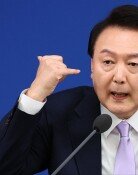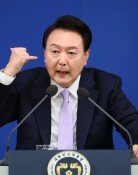Negative signs involving KFX, T-50 projects
Negative signs involving KFX, T-50 projects
Posted October. 26, 2015 09:51,
The Korea Aerospace Industries plan to export 12 units of the Korean made supersonic T-50 advanced trainer jet (worth 400 million U.S. dollars in total) to Uzbekistan has effectively gone up smoke due to Washingtons opposition. As most core technologies including electrical equipment and engine in the T-50, which were developed with technological assistance from Lockheed Martin, are made in the U.S., Korea must win approval from Washington not only when exporting it to overseas markets but also when exhibiting in a foreign country. The U.S. gave permission when Korea exported the plane to Indonesia, Iraq, the Philippines and Thailand.
Uzbekistan has strategic partnership agreement with Russia. The country also has regional security and economic cooperation ties with China as a member of the Shanghai Cooperation Organization. Russia is beefing up its intervention in Syria, and strengthening military leadership in Central Asia, while China is in sharp conflict with the U.S. due to the formers bid to increase its maritime control in South China Sea. Export of the T-50 trainer jet is not simply a matter of agreement between Seoul and Washington but also an issue of international politics. The National Security Strategy report, which the U.S. announced in February, seeks to urge China to follow international rules and regulations in maritime security and territorial dispute, and takes Russia that is providing military aid to Ukraine as a target for blockade and sanctions.
Washingtons refusal to transfer four core technologies owned by Lockheed Martine, the producer of the F-35 stealth fighter, to Korea for Seouls Korea Fighter Experimental (KFX) cannot simply be considered to be just arising from Washingtons concern over technology leaks. Up until when Seoul picked the F-35 as the preferred negotiating partner for the Fighter Experimental (FX) in March 2014, the Korean government claimed that there would be no problem in tech transfer from the U.S. However, the fact Washington notified its denial to transfer technology to South Korea as many as three times from April this year is a situation that cannot be taken lightly. Some Koreans could naturally have complaints that the U.S. is exporting weapons to Korea but is denying technology assistance.
President Park Geun-hye reportedly instructed chiefs of organizations that are involved in the KFX project, including Chang Myung-jin, chief of the Defense Acquisition Program Administration, and Chung Hong-yong, head of the Agency for Defense Development, to make face-to-face reporting. Korea can develop with homegrown technology within 10 years, Kim Kwan-jin, head of the presidential national security office, said at parliamentary inspection of the government by the National Assemblys steeling committee on Friday. Kim served as the defense minister when the FX candidate plane was selected in 2014. Kim cannot be freed from responsibilities for the fiasco over the past several months. Before it gets too late, President Park should thoroughly investigate the truth, and prepare countermeasures now. President Park also need to dismiss those responsible in the foreign affairs and national security line, who have been trying to cover up alarms and only focused on maintaining their careers.







